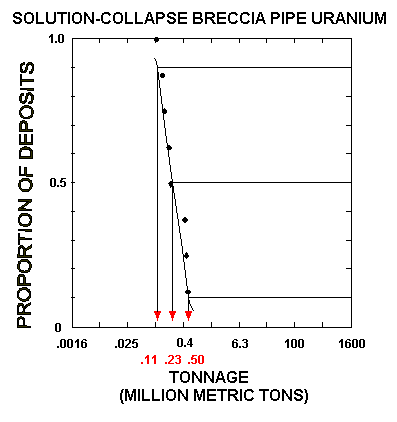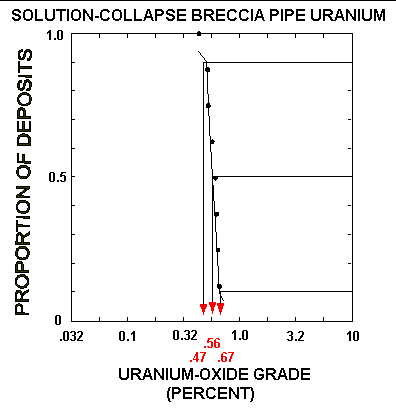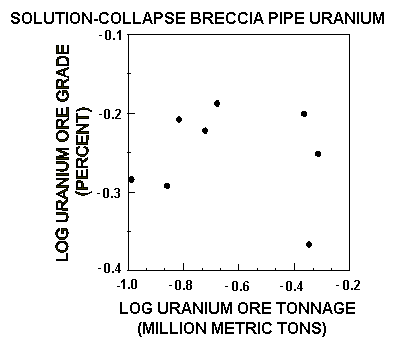GRADE AND TONNAGE MODEL OF SOLUTION-COLLAPSE BRECCIA PIPE URANIUM DEPOSITS
By
Warren I. Finch, Charles T. Pierson, and Hoyt B. Sutphin
COMMENTS
All the deposits in this grade and tonnage compilation are from the Grand
Canyon region of northwestern Arizona. From the many mineralized solution-collapse
breccia pipes in the region, we have chosen eight deposits that contain
mostly primary, unoxidized minerals and have complete, reliable grade
and tonnage data. Other mineralized breccia pipes are deeply eroded, strongly
weathered, depleted in uranium, and enriched by supergene processes to
minable grades of copper, vanadium, and other metals. These remnant deposits
are not considered here to be a separate, distinct class of deposits.
Furthermore, grade and tonnage data of these remnant deposits (Chenoweth,
1988) are too incomplete to graph meaningfully either separately or combined
with the primary deposits.
During
the 1950-70 period when the Orphan Lode was mined, the cutoff grades were
around 0.10 percent U3O8. Few, if any, breccia pipes were mined in the
1970's. In the 1980's, the cutoff grade was 0.20~.35 percent U3O8 for
the remaining seven pipes. The average grade of the Orphan Lode ore mined
in the early period was 0.43 percent U3O8 (Chenoweth, 1986), whereas ores
mined from other pipes in the 1980's averaged about 0.65 percent U3O8
(Mathisen, 1987). The grade and tonnage data used to plot the graphs in
figures 21 and 22 are based on premining reserves calculated at a cutoff
grade of 0.05 percent U3O8. Energy Fuels Nuclear, Inc., operators of all
deposits but the Orphan Lode, kindly permitted the use of data from their
properties. See appendix
B for locality abbreviations. See introduction
for explanation of the grade and tonnage model as shown in figures 21
and 22.
Figure 21. Tonnages of solution-collapse
breccia-pipe uranium deposits.

Figure 22. Uranium-oxide grades of solution-collapse
breccia-pipe uranium deposits.

DEPOSITS
DEPOSITS
Name Country
Name
Country
Canyon
USAZ
Kanab
North USAZ
Hack
No. 1 USAZ
Orphan
Lode USAZ
Hack
No. 2 USAZ
Pigeon
USAZ
Hack
No. 3 USAZ
Pinenut
USAZ
The
scatter plot of the logarithms (to base 10) of grade and tonnage is shown
in figure 23. This plot and the correlation coefficient of -0.122 suggest
that the log-tonnage and log-grade are not correlated. Neither probability
plots nor histograms of the grade and tonnage data demonstrate either
normality or lognormality. Skewness is 0.13 for log-tonnages and -0.90
for log-grades. The mean tonnage and grade are 269,600 metric tons and
0.57 percent U3O8, with standard deviations of 157,370 metric tons and
0.07 percent U3O8, respectively.
Trace-element
contents of five of the eight pipes are shown in table 9. Because the
selected samples were high graded, these data do not represent the average
grade for a given deposit. Hence, grade curves cannot be constructed from
the data. Nevertheless, they do show that the mean value of the elements
As, Co, Cu, Ni, Pb, U. and Zn are high locally within breccia pipe primary
orebodies. Copper, vanadium, gold, and silver have been produced from
some highly oxidized breccia pipe uranium ores (Chenoweth, 1986, 1988).
Figure 23. Scatter plot of logarithms of
average uranium-oxide grade vs tonnage of uranium ore.

Table 9. Summary statistics of chemical
analyses of one selected sample from each of the five solution-collapse
breccia pipe uranium deposits (based on analyses by Wenrich
and Sutphin, 1989, and their unpublished data)
Element
Mean
Standard
deviation
(ppm)
(ppm)
Ag
34
22
As
8,340
6,981
Ba
139
109
Cd
31
40
Ce
102
94
Co
2,044
3,795
Cr
51
68
Cu
11,440
9,340
Fe
4.7
3.7
Ga
21
9
La
17
7
Li
20
16
Mo
403
312
Ni
4,760
5,998
Pb
2,978
2,042
Sr
372
494
U
77,400
65,569
V
121
99
Y
124
112
Zn
9,584
11,469
- Fe values are in percent.


